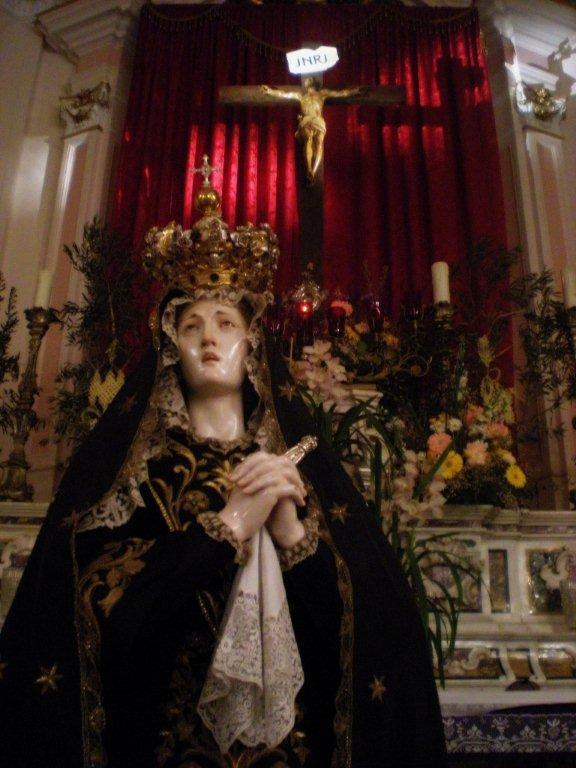The Visit

The construction of the new church of the Servants of Mary began in 1761 and was completed in 1778.It has a single aisle rich in Baroque stucco reliefs the work of the Neapolitan Cesare Starace (1773).It is accessed via a marble staircase with two rails, enriched by two large canvases by F. De Sanctis (1602) representing Saint Mark the Evangelist and Saint Carlo Borromeo, the ancient painting of the Assumption by Nicola Malinconico (1723), the central tondo of the Eternal Father in Glory and the small marble sculpture of Christ crucified, by the famous Sammartino.
The staircase leads to a large vestibule (a cavallo della sottostante strada) where two panels from the ancient tiled floor of the church, are placed by Ignazio Chiaiese (1774); the painting of Saint Stanislaus Kostka by Lorenzo Giusto (1834) and an entirely gilded wooden statue of Saint Catello (1600).
The Holy Temple is accessed via 2 entrances, where, the marble altar, the work of the Neapolitan artist Antonio Troccoli (1772), holds the large painting of the Assumption (1774); the Virgin is depicted at the centre of the composition and at the bottom the Holy Apostles can be seen placed around the Sepulchre.
In the presbytery you can see four other smaller paintings depicting the Archangels (Saint Raffaele, Saint Michele, Saint Gabriele) and the Guardian Angel. Along the walls of the church you can admire the other seven paintings depicting many feasts of the Madonna. (Immaculate Conception, Birth of the Madonna, Madonna at the Temple, Annunciation of Mary, Mary visiting St. Elizabeth, Mary presents Jesus to the Temple, Assumption of Mary to Heaven). All these paintings are the work of Carlo Amalfi (1780 - 1787); interestingly, at the sides of the altar, are both the manger with the shepherds from the 1700s, the chapel dedicated to the Holy Family, with statuettes from the 1600s and various reliquaries. On the chancel above entering, there is an organ painted with floral motifs and embellished with carved wooden cornices and gilded, the work of the Neapolitan Nicola Mancini (1773), recently restored by the firm ARS Bodies Foligno.
In the corridor leading to the Vestry are many paintings, ceramics, documents and French maps from the 1700s as well as several furnishings. In the other rooms are the books of the ancient library of the Franciscans, with manuscripts from the 1400s and interesting volumes ranging from the 1500s to the 1800s, purchased by the state in 1860.
In addition, you can admire paintings of the Founding Fathers, Bishops and Canons of Sorrento, and finally the graceful statue of the Assumption (1700) is a sumptuous robe woven with silver embroidered in gold and studded with pearls, garnets and lapis lazuli, the only kind of work that is in the Diocese. A number of shrines are placed in the central case, and many sacred furnishings in silver, both from the 1700s and the 1800s.
Of particular interest are the two wooden statues of the Virgin Mary and Saint Joseph. "Example of sheperds began to appear in churches and oratories of Naples towards the end of the 1300s" (G. Borrelli). In the capitular hall one can admire the great library positioned in the eighteenth-century shelving of the ancient pharmacist "Leone", a number of paintings attributed to F. Greco, Ribera, GB Lama, C. Amalfi, carved and gilded wooden consoles from the 1700s and the wooden statues of saints from the 1600s and the 1700s. In the central cabinet posts are precious chalices, monstrances, pyx and silver bound missals of the 1700s and the 1800s also of great interest is the tiled floor by Ignazio Chiaiese (1774) that once adorned the sanctuary and also the large painting depicting Saint Antonino and Saint Catello, which was the altarpiece of the church of Saint Catello. In the picture’s background one can see the view of Sorrento and below the Brothers of the Archconfraternity of Death.
In the Vestry there is fine walnut furniture (1600), wooden statuettes of saints from the 1700s and a precious Spanish wooden statue of Our Lady of Sorrows (1600). In a large display cabinet you can find several vestments of silk, Venetian damask or by Saint Leucio, richly embroidered in gold and silver dating from the period 1600 to 1800, unique for their richness and design, perfectly preserved.
On the walls are several paintings, including two by Francesco De Mura and a painting by an unknown, depicting "L'Ecce Homo" (1700).


